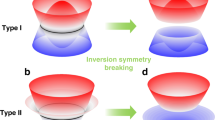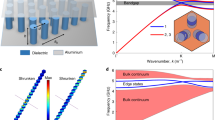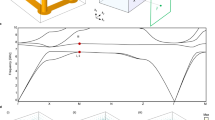Abstract
The hallmark of topological insulators (TIs) is the scatter-free propagation of waves in topologically protected edge channels1. This transport is strictly chiral on the outer edge of the medium and therefore capable of bypassing sharp corners and imperfections, even in the presence of substantial disorder. In photonics, two-dimensional (2D) topological edge states have been demonstrated on several different platforms2,3,4 and are emerging as a promising tool for robust lasers5, quantum devices6,7,8 and other applications. More recently, 3D TIs were demonstrated in microwaves9 and acoustic waves10,11,12,13, where the topological protection in the latter is induced by dislocations. However, at optical frequencies, 3D photonic TIs have so far remained out of experimental reach. Here we demonstrate a photonic TI with protected topological surface states in three dimensions. The topological protection is enabled by a screw dislocation. For this purpose, we use the concept of synthetic dimensions14,15,16,17 in a 2D photonic waveguide array18 by introducing a further modal dimension to transform the system into a 3D topological system. The lattice dislocation endows the system with edge states propagating along 3D trajectories, with topological protection akin to strong photonic TIs19,20. Our work paves the way for utilizing 3D topology in photonic science and technology.
This is a preview of subscription content, access via your institution
Access options
Access Nature and 54 other Nature Portfolio journals
Get Nature+, our best-value online-access subscription
$29.99 / 30 days
cancel any time
Subscribe to this journal
Receive 51 print issues and online access
$199.00 per year
only $3.90 per issue
Buy this article
- Purchase on Springer Link
- Instant access to full article PDF
Prices may be subject to local taxes which are calculated during checkout




Similar content being viewed by others
Data availability
The data that support the findings of this study are available from the corresponding author upon reasonable request.
References
König, M. et al. Quantum spin Hall insulator state in HgTe quantum wells. Science 318, 766–770 (2007).
Wang, Z., Chong, Y., Joannopoulos, J. D. & Soljačić, M. Observation of unidirectional backscattering-immune topological electromagnetic states. Nature 461, 772–775 (2009).
Rechtsman, M. C. et al. Photonic Floquet topological insulators. Nature 496, 196–200 (2013).
Hafezi, M., Mittal, S., Fan, J., Migdall, A. & Taylor, J. M. Imaging topological edge states in silicon photonics. Nat. Photon. 7, 1001–1005 (2013).
Bandres, M. A. et al. Topological insulator laser: experiments. Science 359, eaar4005 (2018).
Barik, S. et al. A topological quantum optics interface. Science 359, 666–668 (2018).
Blanco-Redondo, A., Bell, B., Oren, D., Eggleton, B. J. & Segev, M. Topological protection of biphoton states. Science 362, 568–571 (2018).
Wang, M. et al. Topologically protected entangled photonic states. Nanophotonics 8, 1327–1335 (2019).
Yang, Y. et al. Realization of a three-dimensional photonic topological insulator. Nature 565, 622–626 (2019).
Xue, H. et al. Observation of dislocation-induced topological modes in a three-dimensional acoustic topological insulator. Phys. Rev. Lett. 127, 214301 (2021).
Ye, L. et al. Topological dislocation modes in three-dimensional acoustic topological insulators. Nat. Commun. 13, 508 (2022).
Wang, W., Chen, Z.-G. & Ma, G. Synthetic three-dimensional Z×Z2 topological insulator in an elastic metacrystal. Phys. Rev. Lett. 127, 214302 (2021).
Nayak, A. K. et al. Resolving the topological classification of bismuth with topological defects. Sci. Adv. 5, eaax6996 (2019).
Boada, O., Celi, A., Latorre, J. I. & Lewenstein, M. Quantum simulation of an extra dimension. Phys. Rev. Lett. 108, 133001 (2012).
Luo, X.-W. et al. Quantum simulation of 2D topological physics in a 1D array of optical cavities. Nat. Commun. 6, 7704 (2015).
Ozawa, T., Price, H. M., Goldman, N., Zilberberg, O. & Carusotto, I. Synthetic dimensions in integrated photonics: from optical isolation to four-dimensional quantum Hall physics. Phys. Rev. A 93, 43827 (2016).
Yuan, L., Shi, Y. & Fan, S. Photonic gauge potential in a system with a synthetic frequency dimension. Opt. Lett. 41, 741–744 (2016).
Lustig, E. et al. Photonic topological insulator in synthetic dimensions. Nature 567, 356–360 (2019).
Ran, Y., Zhang, Y. & Vishwanath, A. One-dimensional topologically protected modes in topological insulators with lattice dislocations. Nat. Phys. 5, 298–303 (2009).
Lu, L. & Wang, Z. Topological one-way fiber of second Chern number. Nat. Commun. 9, 5384 (2018).
Malkova, N., Hromada, I., Wang, X., Bryant, G. & Chen, Z. Observation of optical Shockley-like surface states in photonic superlattices. Opt. Lett. 34, 1633–1635 (2009).
Fu, L., Kane, C. L. & Mele, E. J. Topological insulators in three dimensions. Phys. Rev. Lett. 98, 106803 (2007).
Ringel, Z., Kraus, Y. E. & Stern, A. Strong side of weak topological insulators. Phys. Rev. B 86, 45102 (2012).
Slobozhanyuk, A. et al. Three-dimensional all-dielectric photonic topological insulator. Nat. Photon. 11, 130–136 (2017).
Lin, Q., Sun, X.-Q., Xiao, M., Zhang, S.-C. & Fan, S. Constructing three-dimensional photonic topological insulator using two-dimensional ring resonator lattice with a synthetic frequency dimension. Sci. Adv. 4, eaat2774 (2018).
Khanikaev, A. B. et al. Photonic topological insulators. Nat. Mater. 12, 233–239 (2012).
Teo, J. C. Y. & Kane, C. L. Topological defects and gapless modes in insulators and superconductors. Phys. Rev. B 82, 115120 (2010).
Hamasaki, H., Tokumoto, Y. & Edagawa, K. Dislocation conduction in Bi-Sb topological insulators. Appl. Phys. Lett. 110, 92105 (2017).
Kraus, Y. E., Lahini, Y., Ringel, Z., Verbin, M. & Zilberberg, O. Topological states and adiabatic pumping in quasicrystals. Phys. Rev. Lett. 109, 106402 (2012).
Jukić, D. & Buljan, H. Four-dimensional photonic lattices and discrete tesseract solitons. Phys. Rev. A 87, 13814 (2013).
Noh, J. et al. Experimental observation of optical Weyl points and Fermi arc-like surface states. Nat. Phys. 13, 611–617 (2017).
Maczewsky, L. J. et al. Synthesizing multi-dimensional excitation dynamics and localization transition in one-dimensional lattices. Nat. Photon. 14, 76–81 (2020).
Zilberberg, O. et al. Photonic topological boundary pumping as a probe of 4D quantum Hall physics. Nature 553, 59–62 (2018).
Stuhl, B. K., Lu, H.-I., Aycock, L. M., Genkina, D. & Spielman, I. B. Visualizing edge states with an atomic Bose gas in the quantum Hall regime. Science 349, 1514–1518 (2015).
Mancini, M. et al. Observation of chiral edge states with neutral fermions in synthetic Hall ribbons. Science 349, 1510–1513 (2015).
Dutt, A. et al. A single photonic cavity with two independent physical synthetic dimensions. Science 367, 59–64 (2020).
Rudner, M. S., Lindner, N. H., Berg, E. & Levin, M. Anomalous edge states and the bulk-edge correspondence for periodically driven two-dimensional systems. Phys. Rev. X 3, 31005 (2013).
Maczewsky, L. J., Zeuner, J. M., Nolte, S. & Szameit, A. Observation of photonic anomalous Floquet topological insulators. Nat. Commun. 8, 13756 (2017).
Mukherjee, S. et al. Experimental observation of anomalous topological edge modes in a slowly driven photonic lattice. Nat. Commun. 8, 13918 (2017).
Biesenthal, T., Kremer, M., Heinrich, M. & Szameit, A. Experimental realization of PT-symmetric flat bands. Phys. Rev. Lett. 123, 183601 (2019).
Celi, A. et al. Synthetic gauge fields in synthetic dimensions. Phys. Rev. Lett. 112, 043001 (2014).
Lustig, E. et al. in Conference on Lasers and Electro-Optics, paper FW3A.2 (Optical Society of America, 2020).
Leykam, D., Rechtsman, M. C. & Chong, Y. D. Anomalous topological phases and unpaired Dirac cones in photonic Floquet topological insulators. Phys. Rev. Lett. 117, 13902 (2016).
Szameit, A. et al. Discrete optics in femtosecond-laser-written photonic structures. J. Phys. B At. Mol. Opt. Phys. 43, 163001 (2010).
Bernevig, B. A., Hughes, T. L. & Zhang, S.-C. Quantum spin Hall effect and topological phase transition in HgTe quantum wells. Science 314, 1757–1761 (2006).
Hasan, M. Z. & Kane, C. L. Colloquium: Topological insulators. Rev. Mod. Phys. 82, 3045–3067 (2010).
Moore, J. E. & Balents, L. Topological invariants of time-reversal-invariant band structures. Phys. Rev. B 75, 121306 (2007).
Hsieh, D. et al. A topological Dirac insulator in a quantum spin Hall phase. Nature 452, 970–974 (2008).
Roy, R. Topological phases and the quantum spin Hall effect in three dimensions. Phys. Rev. B 79, 195322 (2009).
Bi, R., Yan, Z., Lu, L. & Wang, Z. Topological defects in Floquet systems: anomalous chiral modes and topological invariant. Phys. Rev. B 95, 161115 (2017).
Nag, T. & Roy, B. Anomalous and normal dislocation modes in Floquet topological insulators. Commun. Phys. 4, 157 (2021).
Harari, G. et al. in Conference on Lasers and Electro-Optics, paper FM3A.3 (Optical Society of America, 2016).
Bahari, B. et al. Nonreciprocal lasing in topological cavities of arbitrary geometries. Science 358, 636–640 (2017).
Harari, G. et al. Topological insulator laser: theory. Science 359, eaar4003 (2018).
Dikopoltsev, A. et al. Topological insulator vertical-cavity laser array. Science 373, 1514–1517 (2021).
Mittal, S., Orre, V. V. & Hafezi, M. Topologically robust transport of entangled photons in a 2D photonic system. Opt. Express 24, 15631–15641 (2016).
Dai, T. et al. Topologically protected quantum entanglement emitters. Nat. Photon. 16, 248–257 (2022).
Christodoulides, D. N. & Joseph, R. I. Discrete self-focusing in nonlinear arrays of coupled waveguides. Opt. Lett. 13, 794–796 (1988).
Schwartz, T., Bartal, G., Fishman, S. & Segev, M. Transport and Anderson localization in disordered two-dimensional photonic lattices. Nature 446, 52–55 (2007).
Afzal, S. & Van, V. Trapping light in a Floquet topological photonic insulator by Floquet defect mode resonance. APL Photonics 6, 116101 (2021).
Acknowledgements
We would like to thank C. Otto for preparing the high-quality fused silica samples used for the inscription of all photonic structures in this work. The Technion team gratefully acknowledges the support of an Advanced Grant from the European Research Council (ERC) under the European Union’s Horizon 2020 research and innovation programme (grant agreement no. 789339) and the support of a research grant from the Air Force Office of Scientific Research (AFOSR) of the USA. The Rostock team gratefully acknowledges the support of the Deutsche Forschungsgemeinschaft (grants SCHE 612/6-1, SZ 276/12-1, BL 574/13-1, SZ 276/15-1, SZ 276/20-1 and SFB 1477 ‘Light-Matter Interactions at Interfaces’, project number 441234705) and the Alfried Krupp von Bohlen und Halbach Foundation.
Author information
Authors and Affiliations
Contributions
Eran Lustig and Lukas J. Maczewsky contributed equally to this work. All authors contributed substantially to this work.
Corresponding author
Ethics declarations
Competing interests
The authors declare no competing interests.
Peer review
Peer review information
Nature thanks Avik Dutt, Alexander Khanikaev and the other, anonymous, reviewer(s) for their contribution to the peer review of this work.
Additional information
Publisher’s note Springer Nature remains neutral with regard to jurisdictional claims in published maps and institutional affiliations.
Extended data figures and tables
Extended Data Fig. 1 Unit cell of the 3D photonic TI.
a, The dashed green line is the projection of the trajectory of the two columns of waveguides (blue and red) on the x–y plane. The directions of the helical motion follow the green arrowheads. The two columns are presented here at their closest proximity to one another along the trajectory. The size of each waveguide indicates the different ‘depth’ of refractive index (the largest circle is the deepest waveguide). b, Coupling between adjacent waveguides as a function of their x separation, obtained by different speeds of the laser-writing process, which translates into different refractive index contrast. c, Same as a but at the dislocation, at which the shift creates coupling between localized modes of different 2D layers.
Extended Data Fig. 2 Spectrum of the topological surface states and their typical structure in the presence of intermodal coupling.
a, The amplitude as a function of location and mode in the 3D synthetic space without dislocation for moderate intermodal coupling of 20% of the spatial coupling. b, Same as a but for a lattice with a dislocation. c,d, Floquet spectrum as a function of the state number of a and b, respectively. e–h, Same as a–d but for strong intermodal coupling of 60% of the spatial coupling.
Rights and permissions
Springer Nature or its licensor holds exclusive rights to this article under a publishing agreement with the author(s) or other rightsholder(s); author self-archiving of the accepted manuscript version of this article is solely governed by the terms of such publishing agreement and applicable law.
About this article
Cite this article
Lustig, E., Maczewsky, L.J., Beck, J. et al. Photonic topological insulator induced by a dislocation in three dimensions. Nature 609, 931–935 (2022). https://doi.org/10.1038/s41586-022-05129-7
Received:
Accepted:
Published:
Issue Date:
DOI: https://doi.org/10.1038/s41586-022-05129-7
This article is cited by
-
Finite barrier bound state
Light: Science & Applications (2024)
-
Vortex nanolaser based on a photonic disclination cavity
Nature Photonics (2024)
-
Observation of vortex-string chiral modes in metamaterials
Nature Communications (2024)
-
Topological phenomena at defects in acoustic, photonic and solid-state lattices
Nature Reviews Physics (2023)
-
A second wave of topological phenomena in photonics and acoustics
Nature (2023)
Comments
By submitting a comment you agree to abide by our Terms and Community Guidelines. If you find something abusive or that does not comply with our terms or guidelines please flag it as inappropriate.



